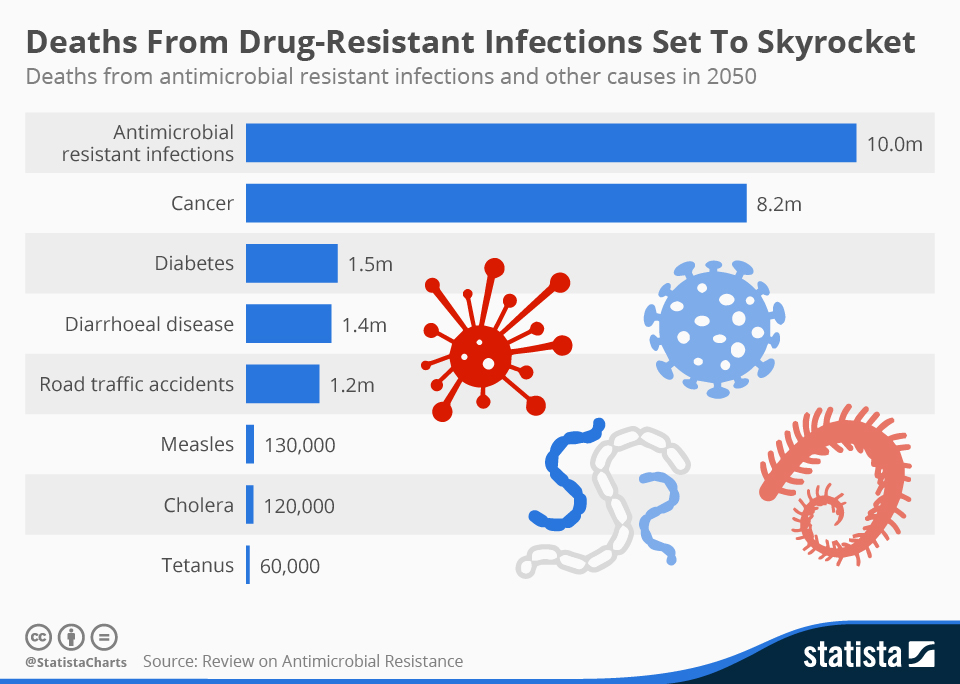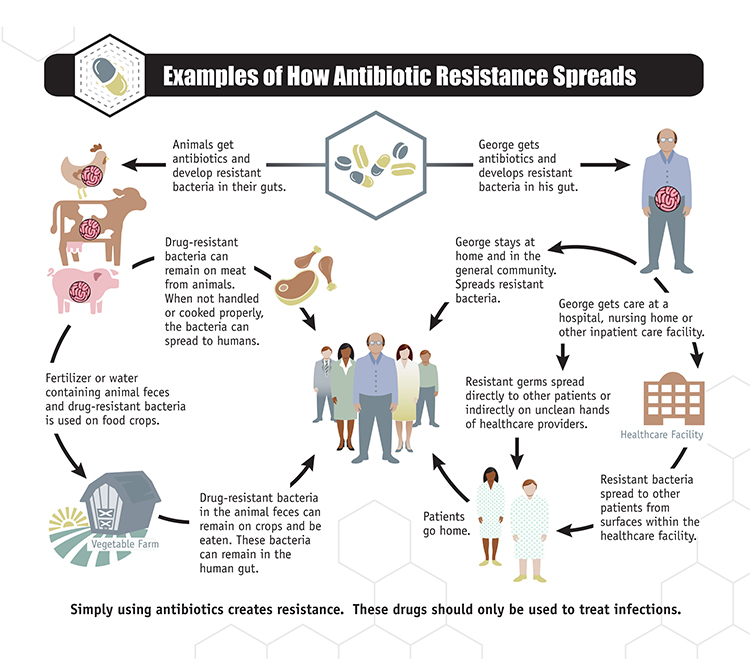Antimicrobials in animals: The possible impacts on human health

Drug use in veterinary practice may include therapeutic and non-therapeutic utilization. Therapeutic use includes; antimicrobials, ecto and endo parasiticides, endectocides, and the drugs acting on various systems. The non-therapeutic application includes the drugs used to increase feed conversion efficiency that entails antimicrobial growth promoters, anabolic steroids, and hormones like oxytocin, growth hormone, etc. Animal products, in addition to naturally occurring toxicants, can also contain residues from agricultural pesticides used within or around the vicinity of animal farms and environmental contaminants present in animal feed, water, or ambient air. The levels of drugs used in veterinary medicine are a public health concern when such animals or their products are used for human consumption.
Antimicrobial exercise in food animals also involves therapeutic use to treat clinical disease and prophylactic use to prevent and control common disease events. While these drugs are used to prevent and treat illness in farmed animals, they’re also used in low doses to make animals grow more quickly and to compensate for unhygienic conditions. When approved veterinary drugs are administered according to their label directions, the prevalence of violative drug residues in animal products should be less than 1%. Residue violation rates greater than 1% indicate drug use in a manner inconsistent with label directions. The overwhelming majority of violations are from antimicrobials, and the salvaging of antimicrobial treated diseased animals for slaughter is a common cause of violative drug residues. Medicated feeds are also a frequent cause of residue violations. The low doses of antimicrobials are non-lethal to most bacteria and allow bacteria to mutate and become resistant.
In many parts of the world, fish farming is integrated with sewage or industrial wastewater or with land agriculture, since manure and other agricultural residues are commonly employed in fish feed. Overcrowding and unhygienic practices encountered in this intensive, industrial-scale fish production act as stressors to the fish, which compel for increased use of antimicrobial prophylaxis. Moreover, even though the aquaculture use of these antimicrobial growth promoters has been discontinued in most developed countries, therapeutic treatment of fish is generally carried out en masse via inclusion in fish food, which results in exposure of the entire body of water to the antibiotic.
Leaching of antibiotics from unconsumed food and feces into the water and pond sediments exerts selective pressures on the sediment and water microflora. These residues can also be washed to more distant sites, exposing wild fish and shellfish and also other animals, including humans, to trace antimicrobials. Historically, the transfer and emergence of resistance have occurred faster from aquatic bacteria to humans than from terrestrial animal bacteria to humans. The use of one agent could also produce cross-resistance to the other.
Antibiotic resistance is a serious global health problem that increases the formation of hard-to-treat, drug-resistant bacteria, the superbugs. An estimated 23000 deaths costing 20-35 billion USD annually in the U.S., 25000 deaths costing 1.5 billion Euros annually in Europe, and 58000 Neonatal Sepsis Deaths annually in India, are incriminated to drug resistance. In 2013, pneumonia was responsible for an estimated 935,000 deaths worldwide in children under five. If given effective antibiotic treatment, most of these children would not have died. One estimate by the U.K. government warns that drug-resistant infections could cost the world up to $100 trillion in lost output by 2050. Experts at the Centers for Disease Control and Prevention and the World Health Organization warn that humanity may find itself in a “pre-antibiotic era” where even routine medical procedures and dental work could cause fatal infections. A study predicted that by 2050, about 10 million people would die each year as a result of such infections.

Residues of antimicrobial animal drugs also raise special human safety concerns with regard to allergic reactions and carcinogenicity. Ordinary cooking procedures for meat, even to “well done,” cannot be relied on to inactivate drug residues. More severe heating for canning or prolonged cooking with moist heat can inactivate the more heat-sensitive compounds, such as penicillins and tetracyclines, but the nature of degradation products is unknown in most cases. Allergic reactions from antibiotic use may range from lesser reactions such as rashes to life-threatening anaphylaxis. Veterinary drug residues do not cause primary sensitization of individuals because exposures are too low and for a short duration. However, violative residues of animal drugs in food have the potential to cause allergic reactions in sensitive individuals.

Image source: CDC, USA
Idiosyncratic, non-dose-dependent aplastic anemia can occur in humans exposed to chloramphenicol. Nitroimidazoles (e.g., metronidazole), nitrofurans (e.g., nitrofurazone), and carbadox are banned for veterinary use due to carcinogenicity potential. Other carcinogenic agents include sulfamethazine, oxytetracycline, and furazolidone.
Antimicrobials are known to interfere with the manufacture of dairy products. Concentrations of 1 ppb delay starter activity for cheese, butter, and yogurt. They also decrease the acid and flavor production associated with butter manufacture and reduce the curdling of milk, resulting in improper ripening of cheeses.
Although the use of antibiotics can be a beneficial aid in the improvement of animal production, antibiotics should never be intended to replace the need for good management practices, given that the use of antibiotics will eventually lead to the above hazardous conditions. Prudent or judicious use of antimicrobials mandates the optimal selection of drug, dose, and duration of antimicrobial treatment, along with the reduction of the inappropriate and excessive use as a means of slowing the emergence of antimicrobial resistance. Veterinarians, ensuring antimicrobial stewardship, can fulfill the dual roles of protecting animals from pain and suffering while simultaneously safeguarding public health. Common farmers and animal producers also have the responsibility in this milieu by avoiding indiscriminate and over the counter use of antimicrobials.
References
Antimicrobial Therapy in Veterinary Medicine. 2013. John Wiley and Sons, Inc
Centre for Disease Dynamics Economics and Policy, 2015
Clin Microbiol Rev. 2011, 24(4): 718–733.
State of the World’s Antibiotics, 2015. CDDEP: Washington, D.C


